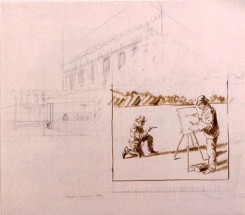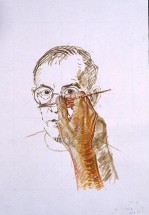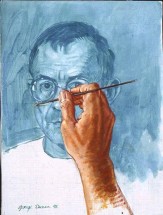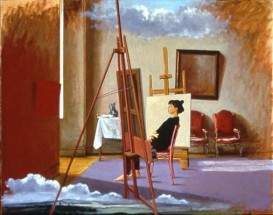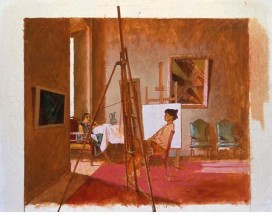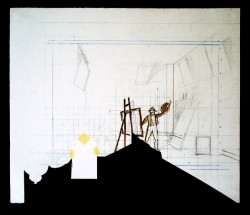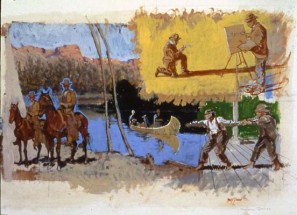| WorkEasel Painting
New Britain Museum of American Art, New Britain, Connecticut. Gift of the Estate of George Deem. Accession Number 2013.54.36 The big painting, Easel Painting... is a theory of image-making that denies the centrality, the harmony of composition, the wholeness, which together constitute the reality effect in the representational, realistic tradition. ...Deem has been developing this theory of image-making in painting after painting throughout his career. In his ongoing meditations on Vermeer, for example, Deem comments on picture-making in Western painting, as well as on picture-making in general, through a relentless critique of illusionism. If this painting has no center, how can we look at its vertiginous collapse of different worlds? It makes sense to "read" this painting. It has stories to tell; it is a text as much as it is an image. Not one story but many, bleeding into each other like the different domains in Jorge Luis Borges' stories. You move from left to right and from top to bottom, exactly as you read a text... Why can the portrait of the woman not be a center to this painting? She, or it, is sitting still enough, "being" an image. She is, moreover, painted in a flattening mode. In one mode of looking, a mode that acknowledges the layering that guides the eye, she sits in front of the easel. In another, the mode of looking that grazes the surface, her impressionistic rendering flattens her picture so that no distinction between front and back, woman and represented easel, can be maintained. But, at this point, it becomes clear that the canvas on the represented easel is bare. Deem, who has been probing the point of emptiness, of unfinishedness, and of restraint throughout his career, makes a theoretical point about image-making through this bare surface. All these images surrounding the woman converge in Easel Painting, not on a vanishing point, but on flat emptiness. An emptiness situated on a painter's canvas no less. This bare canvas projects the painting, whose trace it is, into the future. (Mieke Bal, "George Deem and Peter Angelo Simon: Timely Conversation." Exhibition catalogue essay, George Deem and Peter Angelo Simon; Paintings and Photographs in Conversation, Evansville Museum of Arts and Science, Evansville, Indiana, 2001). | Image Notes| Artist's Notes| Exhibitions |




